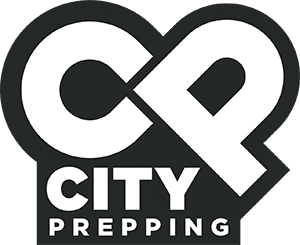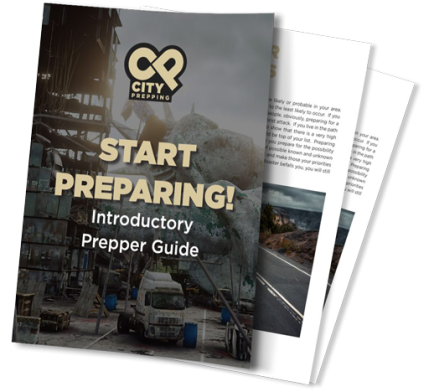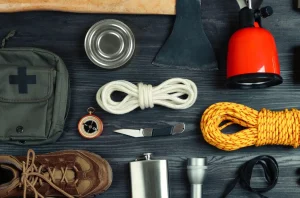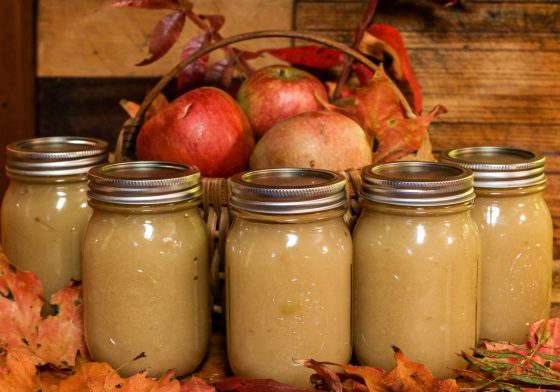- Water storage, filtration, and purification
 The general rule of thumb is to store 1 gallon of water per person, per day…and that’s just the bare minimum. 2 gallons is much more advisable. Also, don’t forget your pets. So if we start with 1 gallon of water, you can pick up 1 gallon water containers at your local store. Please remember that since these are in a clear container, bacteria and algae can start growing inside the container requiring filtration and purification. If you start off with these 1 gallon options, be sure to store them in a cool, dark dry place and rotate them every 6 months or so. When you’re ready to step up to a better option, we would recommend simple 5 or 7 gallon water containers that are BPA free, food grade, and have a dark wall. If properly stored, these can last for many years. The advantage with these options is their mobility. If you want a more permanent solution that can hold more water, you might want to consider a 55 gallon drum.
We have 5 in my family, so if we want enough water for the bare minimum for 3 days, that would be 3 x 5 = 15 gallons. Again, this is just a starting point and we recommend shooting for at 2 weeks if possible.
Just as important as the ability to store is the ability to filter and treat it. My recommendation for those starting out is a sawyer mini water filter along with water purification tablets to help remove bacteria. If you’d prefer to not spend the money on these options, of course you can boil the water to kill organisms, but it will not remove contaminants in the water like a filter plus boiling requires a fuel source. For $20, it’s hard to beat a small filter, plus they’re very portable.
The general rule of thumb is to store 1 gallon of water per person, per day…and that’s just the bare minimum. 2 gallons is much more advisable. Also, don’t forget your pets. So if we start with 1 gallon of water, you can pick up 1 gallon water containers at your local store. Please remember that since these are in a clear container, bacteria and algae can start growing inside the container requiring filtration and purification. If you start off with these 1 gallon options, be sure to store them in a cool, dark dry place and rotate them every 6 months or so. When you’re ready to step up to a better option, we would recommend simple 5 or 7 gallon water containers that are BPA free, food grade, and have a dark wall. If properly stored, these can last for many years. The advantage with these options is their mobility. If you want a more permanent solution that can hold more water, you might want to consider a 55 gallon drum.
We have 5 in my family, so if we want enough water for the bare minimum for 3 days, that would be 3 x 5 = 15 gallons. Again, this is just a starting point and we recommend shooting for at 2 weeks if possible.
Just as important as the ability to store is the ability to filter and treat it. My recommendation for those starting out is a sawyer mini water filter along with water purification tablets to help remove bacteria. If you’d prefer to not spend the money on these options, of course you can boil the water to kill organisms, but it will not remove contaminants in the water like a filter plus boiling requires a fuel source. For $20, it’s hard to beat a small filter, plus they’re very portable.
- Food
 calories of consumption per day for adults. Any less than 1200 calories and you’re starting to starve. Most would be ok with roughly 2000 calories per day if not exerting themselves. But realistically, after a disaster, it is very possible you’ll be moving a good deal more, especially if you’re needing to walk long distances or do strenuous chores. For this, expect to need roughly around 3000 calories. Ideally, a balance of macronutrients (fats, carbs, and proteins) can be had through a combination of these various food items that you can stored away.
calories of consumption per day for adults. Any less than 1200 calories and you’re starting to starve. Most would be ok with roughly 2000 calories per day if not exerting themselves. But realistically, after a disaster, it is very possible you’ll be moving a good deal more, especially if you’re needing to walk long distances or do strenuous chores. For this, expect to need roughly around 3000 calories. Ideally, a balance of macronutrients (fats, carbs, and proteins) can be had through a combination of these various food items that you can stored away.
- 20 lbs of white rice
- 20 lbs of beans
- 20 cans of fruit
- 20 cans of vegetables
- 20 cans of meat
- 2 containers of peanut butter
- Butter (ideally powerded)
- Drink sweetener such as tang (optional based on your preferences)
- 2 bags of flour
- 1 bag of sugar
- 1 bag of salt
- 1 lb of oats
- 1 gallon of olive oil
- First Aid

- Tourniquet. If someone in your family has a major laceration, a tourniquet could stabilize them until you get medical attention.
- Gloves
- Sunscreen
- Tissue adhesive
- ACE bandage
- Antibiotic ointment
- Anti-itch cream
- BZK antiseptic
- Bandaids
- Pain meds
- Sting and bit relief
- Anti-diarrheal medication
- Quickclot
- Gauzes
- Pepto Bismol
- Israeli bandage
- Moleskin
- Sanitation
 down, being able to properly discard of human waste is a consideration that many overlook. Simply defecting or urinating in your backyard without a proper setup is a sanitary issue waiting to get out of hand.
Here are simple items to have on hand:
down, being able to properly discard of human waste is a consideration that many overlook. Simply defecting or urinating in your backyard without a proper setup is a sanitary issue waiting to get out of hand.
Here are simple items to have on hand:
- Soap
- Sanitizer
- Toilet Paper
- Toilet (either one you make or a premade option)
- Ability to cook
 There are a few things you need to consider when thinking about cooking after a disaster. Who do you want to know that you have food and a means to cook and how much fuel do you have stored up? Both factor into what approach you’ll take. For those starting out, my recommendation is often to simply get a camping stove with propane. Or you can use something like a rocket stove which can be fueled with small amounts of biomass that you can find laying around most areas such as twigs and other dried material. We usually discuss utensils to have on hand, but if you’re staying home, you should have the basic pots, pans, forks, knives, spatulas, etc.
There are a few things you need to consider when thinking about cooking after a disaster. Who do you want to know that you have food and a means to cook and how much fuel do you have stored up? Both factor into what approach you’ll take. For those starting out, my recommendation is often to simply get a camping stove with propane. Or you can use something like a rocket stove which can be fueled with small amounts of biomass that you can find laying around most areas such as twigs and other dried material. We usually discuss utensils to have on hand, but if you’re staying home, you should have the basic pots, pans, forks, knives, spatulas, etc.
- Power source and lighting
 and old age. Simple things you can purchase now are AA and AAA batteries. We have switched my electronics over to devices that can be powered through a USB plugin so having a simple hand crank to charge them or a solar panel would be an option. If you go the solar panel route, best to have a small battery bank that can be charged. Entry-level solar panels combined with a small battery bank could be enough to keep your cell phone or other small electronics powered. The next step up is picking up either gas or solar generator. We have both options and the cost of these varies widely. We would recommend watching my video entitled “How Much Power Will I Need to Survive?” which goes into great detail breaking down wants versus needs when it comes to power generation. If you’re just starting out, something like a Champion dual fuel generator from Costco would be a good starting point. Solar generators are nice, but they’re expensive and don’t provide on-demand power like an internal combustion generator. On the other hand, they produce no noise or fumes if you’re wanting to keep your ability to produce power to yourself and with solar panels, you have a renewable, infinite power source.
Regarding lighting, while we have a propane coleman latern, we have started adding USB chargeable lighting options that can be recharged. The options on the market have exploded over the last few years and being able to hook these up to a either a small solar panel or generator works for me.
and old age. Simple things you can purchase now are AA and AAA batteries. We have switched my electronics over to devices that can be powered through a USB plugin so having a simple hand crank to charge them or a solar panel would be an option. If you go the solar panel route, best to have a small battery bank that can be charged. Entry-level solar panels combined with a small battery bank could be enough to keep your cell phone or other small electronics powered. The next step up is picking up either gas or solar generator. We have both options and the cost of these varies widely. We would recommend watching my video entitled “How Much Power Will I Need to Survive?” which goes into great detail breaking down wants versus needs when it comes to power generation. If you’re just starting out, something like a Champion dual fuel generator from Costco would be a good starting point. Solar generators are nice, but they’re expensive and don’t provide on-demand power like an internal combustion generator. On the other hand, they produce no noise or fumes if you’re wanting to keep your ability to produce power to yourself and with solar panels, you have a renewable, infinite power source.
Regarding lighting, while we have a propane coleman latern, we have started adding USB chargeable lighting options that can be recharged. The options on the market have exploded over the last few years and being able to hook these up to a either a small solar panel or generator works for me.
- Have cash on hand
 If you were to go to a store and the power was out or charging your card was not available, then what? We have increasingly become a cashless society and we’ve become accustomed to charging purchases with our credit or debit cards. Having a backup amount of cash on hand broken down into small denominations will allow you to make purchases when simply charging your card is not available. Again, make sure you store small denominations of 1’s, 5’s, and 10’s. If you only have 20’s, 50’s, or 100’s, someone may not be able to make change for you.
If you were to go to a store and the power was out or charging your card was not available, then what? We have increasingly become a cashless society and we’ve become accustomed to charging purchases with our credit or debit cards. Having a backup amount of cash on hand broken down into small denominations will allow you to make purchases when simply charging your card is not available. Again, make sure you store small denominations of 1’s, 5’s, and 10’s. If you only have 20’s, 50’s, or 100’s, someone may not be able to make change for you.
- Communications
 you can also pick up local stations and national weather services. When most people get started in prepping, picking up a HAM radio, namely the BAOFENG UV-5R is a popular choice. While there are much better options on the market and we plan on doing a comprehensive video on this early next year, it’s a starting point. HAM radios are a popular option as you can potentially communicate far distances if you can pick up a local repeater. We also keep a Garmin inreach mini which allows me to communicate via text over satellite (a monthly fee is required for this service) and we just recently picked up the Starlink satellite service. As long as you have a power source and a view of the sky, you can get full internet access. This also requires a monthly service fee.
you can also pick up local stations and national weather services. When most people get started in prepping, picking up a HAM radio, namely the BAOFENG UV-5R is a popular choice. While there are much better options on the market and we plan on doing a comprehensive video on this early next year, it’s a starting point. HAM radios are a popular option as you can potentially communicate far distances if you can pick up a local repeater. We also keep a Garmin inreach mini which allows me to communicate via text over satellite (a monthly fee is required for this service) and we just recently picked up the Starlink satellite service. As long as you have a power source and a view of the sky, you can get full internet access. This also requires a monthly service fee.
- OPSEC and Self Defense
 OPSEC stands for operational security. After a disaster, keeping your information as to what you have is important. Why? Normal, everyday kind people are capable of acts they themselves could not fathom under the wrong situations. If you or your children were dying from dehydration or starvation, would you do anything to prevent this from happening? Depending on how long the disaster goes or how desperate opportunistic individuals become, keeping your preps private is a critical first step.
Next, when it comes to protection, there are options depending on again, your budget. Whether that’s pepper spray, a stun gun, and/or a firearm, have a plan in place. While we hope it never gets to that point that we’re left defending our home, be sure to think this through.
OPSEC stands for operational security. After a disaster, keeping your information as to what you have is important. Why? Normal, everyday kind people are capable of acts they themselves could not fathom under the wrong situations. If you or your children were dying from dehydration or starvation, would you do anything to prevent this from happening? Depending on how long the disaster goes or how desperate opportunistic individuals become, keeping your preps private is a critical first step.
Next, when it comes to protection, there are options depending on again, your budget. Whether that’s pepper spray, a stun gun, and/or a firearm, have a plan in place. While we hope it never gets to that point that we’re left defending our home, be sure to think this through.
- Mobility
 place. How do we plan for this? One of the most popular discussions within this community is the bug out bag. Having the critical gear in a bag to ensure we can survive for 3 days is something each member of our family has on standby. It’s important to note that without a specific place to flee to leaves you as a refugee. You’re exposed to the elements and a potentially hostile environment. But there may come a time where we have no choice but to leave. We’ve done various blogs about building a bug out bag and places to go to which we’ll link below. Regardless whether you have the best bag in the world with the top of the line gear is irrelevant. What is important is having a plan that allows you to leave your home quickly if factors beyond your control necessitate it.
Conclusion
Hopefully, this blog gave you enough information to get you on your path of preparedness. Again, there’s an accompanying download guide we’ll post a link below if you’d like to download that for free.
2022 is already shaping up to be a year with potentially many challenges. While we are not suggesting we’re spiraling toward some doomsday, apocalyptic scenario, we think many are waking up to the reality that having some level of self-sufficiency is wise.
If you have any questions or concerns, please post those in the comment section below. As always, stay safe out there.
place. How do we plan for this? One of the most popular discussions within this community is the bug out bag. Having the critical gear in a bag to ensure we can survive for 3 days is something each member of our family has on standby. It’s important to note that without a specific place to flee to leaves you as a refugee. You’re exposed to the elements and a potentially hostile environment. But there may come a time where we have no choice but to leave. We’ve done various blogs about building a bug out bag and places to go to which we’ll link below. Regardless whether you have the best bag in the world with the top of the line gear is irrelevant. What is important is having a plan that allows you to leave your home quickly if factors beyond your control necessitate it.
Conclusion
Hopefully, this blog gave you enough information to get you on your path of preparedness. Again, there’s an accompanying download guide we’ll post a link below if you’d like to download that for free.
2022 is already shaping up to be a year with potentially many challenges. While we are not suggesting we’re spiraling toward some doomsday, apocalyptic scenario, we think many are waking up to the reality that having some level of self-sufficiency is wise.
If you have any questions or concerns, please post those in the comment section below. As always, stay safe out there. 





